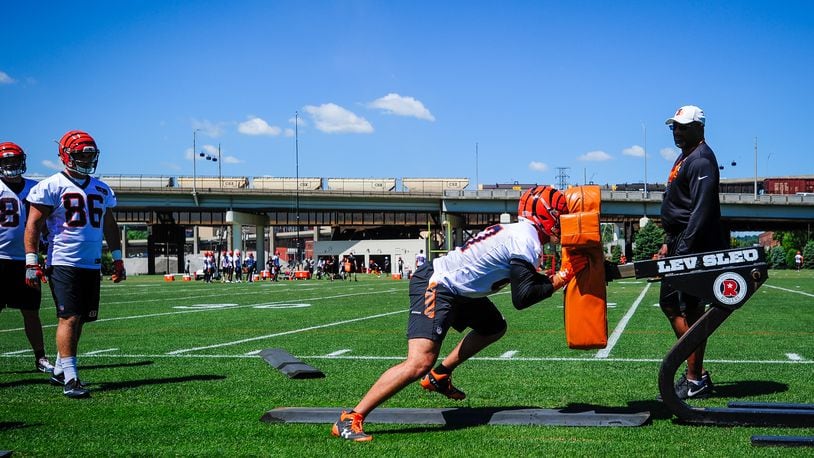For Ross, it was a diploma from the University of Washington.
"It was probably bigger than getting drafted in my opinion, just because I feel like it's something that can't be taken away from you," Ross said. "It was something for my family. I was the first generation to graduate in my family, so it was pretty big for me and everybody.
"I just know how important it was, just to see my parents faces after I graduated, to see how happy my father was, how happy my mom was."
Meanwhile, Mixon has dropped 10 pounds from the 238 he weighed during rookie minicamp
"I'll never be that big again. Never," he said. "Honestly, I was just working out hard and lifting heavy, so I started bulking up. Once I started running a lot, I started trimming down.
"I just watched my diet a little more and I ran a lot," he said. "A lot of cardio. Like hundreds for a set. Right now I feel great."
He blamed the pre-draft dinner circuit for the extra weight, which is understandable.
Seems crucial he stays trim if they plan to use him as an open-field weapon rather than a between-the-tackles runner.
Meanwhile, I am wondering if the Bengals’ most important rookie might be one on the other side of the ball.
Carl Lawson of Auburn has a chance to inject some energy into the defense, and coach Marvin Lewis said he likes what he has seen as the rookie transitions to linebacker.
He played end in college.
"He's played on his feet in the defense at Auburn. It's not anything that foreign to him that we're asking him to do. He's a smart guy, he's conscientious. He needs an every-down position. I don't think right now that he has quite the frame to be an every-down defensive end in the NFL. He's got a great opportunity to affect the game in the positions we're playing him."
Lawson is am impressive guy to watch and to talk to.
If he can get to the quarterback as a rookie, he can make the jobs of a lot of other guys easier, too...
The Reds lost another game to the awful Padres late last night, a 6-2 decision that dropped Cincinnati into last place in the NL Central.
Maybe predictions they won’t be picking in the top five again next June were premature?
Last night, Clayton Richard handcuffed the Reds for 8 2/3 innings while Scott Feldman turned in another below-average start.
Sadly, Feldman’s line (four runs on eight hits in five innings) could also be spun as one that gave his team a chance to win, at least when compared to what happens most nights, but that is missing the bigger picture.
The rotation has been such a disaster no longer is it sufficient to say maybe they can tread water. This team is officially on drown watch, and I’m not too sure Homer Bailey, Anthony DeSclafani and Brandon Finnegan are going to be able to revive the patient by the time they are ready to return.
Takeaways from the NBA Finals and a look at what's next for the league, LeBron James and more https://t.co/dXIKjUEVmy pic.twitter.com/o6qhWrNpoY
— daytonsports (@daytonsports) June 13, 2017
All that said, it's safe to focus on the future, namely the potential of young Hunter Greene.
To try to guess what kind of chances Greene has of making it to Cincinnati, I took a look at the team’s history with No. 1 picks.
More than half Cincinnati Reds first round picks since 1965 have made The Show https://t.co/f9YUmaKCKF pic.twitter.com/4A2JjaEqvp
— Marcus Hartman (@marcushartman) June 14, 2017
Given how many of the pitchers they’ve chosen in the last 15 years or so who have run into arm troubles, I was surprised that overall more than half of their picks have made it to the majors for at least a cup of coffee.
The numbers were roughly the same for position players, which also surprised me.
RELATED: Badin’s Nichting taken in ninth round of MLB draft
A closer look could reveal more interesting info, but if you're wondering how their success rate compares to the rest of the league, I found one study from Baseball America that gives us a hint.
They found in analyzing drafts from 1987-2008 (this is just the first story I found so I’m not sure if there is a newer one available) the rate of first-rounders making the majors was 64 percent — nearly 10 points higher than the Reds.
Of course the time periods aren’t the same, so when I get a chance I will break down that period. More recent results are obviously going to be more useful than those from the 1960s and ‘70s, of course, given all the changes in scouting, development, etc…
About the Author
